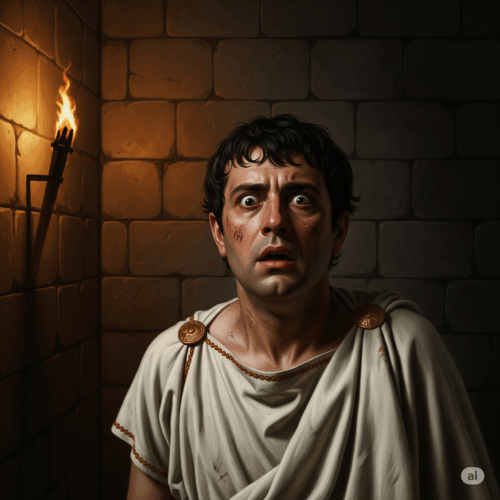Imagine the silence of a Roman villa on a hot summer night, a silence thick with fear and betrayal. The most powerful man in the world is hiding, his empire crumbling around him, his every breath a gasp of desperation. This isn’t the plot of a prestige drama; it was the reality for Emperor Nero on this very day, June 9th, in the year 68 AD. On this day, the once-invincible ruler, declared a public enemy by his own Senate, took his own life, famously lamenting, “What an artist dies in me!”
His dramatic and pathetic end was more than just the death of a man; it was the death of a dynasty. It was a full-stop on the Julio-Claudian line of emperors that had begun with the great Augustus. The immediate outcome was chaos. The power vacuum left by Nero’s demise plunged the Roman Empire into a bloody civil war known as the “Year of the Four Emperors,” a period of profound instability and uncertainty. But what if we told you that this ancient collapse, this story of a tyrant’s fall, holds the secret to building an unshakable foundation for your own life today? It’s a story about the danger of an unexamined life and the incredible opportunity that can arise from even the most devastating personal collapses.
 ### The Man Who Mistook Applause for Achievement
### The Man Who Mistook Applause for Achievement
To understand the lesson, you have to understand the man. Nero’s reign is a masterclass in misplaced priorities and the perils of an unchecked ego. He ascended to the throne as a teenager, but his true passions weren’t in governance, military strategy, or the welfare of his people. Nero saw himself as an artist—a poet, a musician, a charioteer. He craved the adoration of the crowd, not the quiet respect earned through competent leadership.
He spent fortunes on lavish projects like his “Golden House,” a sprawling palace built on the ashes of the Great Fire of Rome (a fire many Romans believed he started). He forced citizens to attend his hours-long musical performances, locking the doors so no one could leave, and planting soldiers in the audience to enforce enthusiastic applause. While he was composing odes and racing chariots, the empire’s frontiers were under threat, the treasury was being drained, and deep resentment was simmering among the military and the political elite.
Nero wasn’t just a bad leader; he was the architect of his own destruction. He systematically eliminated anyone he perceived as a threat—including his own mother, his first wife, and his respected tutor, the philosopher Seneca. He surrounded himself with sycophants who would applaud his every whim, creating an echo chamber that insulated him from reality. He built an empire of one, for one.
So when the rebellions finally came, first in the provinces and then with the support of the Senate, Nero was utterly alone. He had no loyal allies, no reservoir of goodwill, and no practical skills to navigate the crisis. His entire identity was built on a fragile foundation of forced adulation and opulent fantasy. When that shattered, there was nothing left. His death wasn’t just a political event; it was the inevitable collapse of a life lived without substance, authenticity, or a true succession plan.

### From Imperial Chaos to Personal Clarity
The “Year of the Four Emperors” that followed was a brutal lesson for Rome. Without a clear successor, legions from across the empire marched on each other, each backing their own general for the throne. It was a stark reminder that when a system is built entirely around one unstable individual, its collapse is catastrophic.
Now, look at your own life. You are the emperor of your own small, personal empire—your career, your relationships, your health, your personal growth. And like Nero, you might be propping up parts of this empire with fragile materials. Perhaps it’s the “forced applause” of social media likes, the “golden house” of a job you hate but that looks impressive, or the “tyranny” of self-sabotaging habits you refuse to confront. We all have our Neronian tendencies.
A personal collapse—losing a job, the end of a relationship, a health crisis, or simply a profound sense of disillusionment—can feel like the end of the world. It can feel like your own “Year of the Four Emperors,” a chaotic power vacuum where you don’t know who is in charge anymore. But here is the profound lesson from June 9th, 68 AD: **The collapse of a false structure is a mandatory prerequisite for building a true one.**
Nero’s fall created the space for a new, more stable dynasty to eventually emerge. Your personal crises do the same. They are terrifying, but they are also a once-in-a-lifetime opportunity to dethrone the parts of you that are ruling without integrity and to consciously design a life—and a legacy—that is authentic, resilient, and built to last. It’s time to create your own succession plan.

### Your Personal Succession Plan: A Blueprint for an Authentic Life
This isn’t about planning for your demise; it’s about planning for your *life*. It’s about deciding who you want to be after the old version of you has been declared a “public enemy” by your own conscience. It’s about ensuring that what you build next has a foundation so strong it will stand long after you’re gone.
* **Step 1: Audit Your Inner Empire & Identify Your “Nero”**
* **The Problem:** Nero was ruled by his vanity and ego. We all have a “Nero” inside us—the part that craves external validation, chases superficial status, fears criticism, and prioritizes looking good over being good.
* **The Plan:** Get brutally honest with yourself. Grab a journal and create two columns. In the first, list the things you do for “applause” (e.g., posting a certain image on social media, staying in a prestigious but soul-crushing job, buying things to impress others). In the second, list what you would do if no one was watching—your genuine passions and values. This audit reveals the parts of your empire built on sand. The goal is to consciously shift your energy and decisions from the first column to the second.
* **Step 2: Dethrone Your Inner Tyrant**
* **The Problem:** Nero eliminated anyone who challenged him. Our inner tyrants are our self-sabotaging habits and limiting beliefs. It’s the voice that says “you’re not good enough,” the habit of procrastination on important goals, or the addiction that keeps you from being present.
* **The Plan:** Choose one “tyrannical” habit that is holding you back. Just one. For the next 30 days, your mission is to overthrow it. Don’t just stop the habit; replace it. If your tyrant is mindless scrolling, replace it with reading one chapter of a book. If it’s negative self-talk, actively replace every negative thought with a neutral or positive one. This is your personal rebellion. Starve the tyrant of its power by feeding its replacement.

* **Step 3: Draft Your Real Succession Plan (Your Legacy)**
* **The Problem:** Nero’s legacy was chaos and a punchline. He left nothing of value behind. A succession plan isn’t about who gets your stuff; it’s about what of you remains in the world.
* **The Plan:** Define your legacy in three specific areas. **1. Knowledge & Skills:** What do you want to master and be able to teach? (e.g., becoming a skilled woodworker, mastering a language, becoming the go-to expert on a topic at work). **2. Values in Action:** How do you want people to describe you? (e.g., “She was incredibly kind,” “He always acted with integrity”). Write down specific actions you can take daily to embody these values. **3. Tangible Project:** What is one long-term project you can work on that will outlast you? (e.g., planting a garden, creating a family recipe book, mentoring a younger colleague, starting a small community initiative). This is your “Colosseum,” built not for spectacle, but for substance.
* **Step 4: Build Your Senate of Advisors**
* **The Problem:** Nero surrounded himself with “yes-men” and killed his honest critics. This created a fatal blind spot.
* **The Plan:** You need a personal “Senate”—a small group of 3-5 people who you can be completely vulnerable with and who are empowered to tell you the hard truths. This isn’t just your friends who cheer you on. It’s a mentor who challenges you, a friend who calls you out on your nonsense, a family member who knows your history. Actively seek their counsel this month. Present them with a challenge you’re facing and ask for their unvarnished opinion. This Senate is your safeguard against the echo chamber of the ego.
* **Step 5: Embrace Your “Year of Four Emperors”**
* **The Problem:** We fear chaos. We see periods of uncertainty as failures.
* **The Plan:** Reframe your personal crises. When you are in a period of flux, see it as your “Year of Four Emperors.” It’s a messy, uncomfortable, but necessary transitional phase. It’s the period where you get to try on different leadership styles for your own life. Maybe you try being more disciplined (the Emperor Galba), more compassionate (the Emperor Otho), or more strategic (the Emperor Vespasian, who ultimately brought stability). Allow yourself to experiment and fail during these times. This is not the final stage; it’s the audition process for finding the authentic, stable ruler within you.
The fall of a tyrant on a hot June day centuries ago teaches us that the most magnificent structures can be the most fragile. True strength doesn’t come from external validation or dominating control. It comes from self-awareness, integrity, and a life built on a foundation of authentic values. Don’t wait for a full-scale rebellion to force your hand. Start today. Audit your empire, dethrone your inner tyrant, and begin drafting the succession plan for a life of real, lasting substance. Build a legacy that doesn’t end with the desperate cry of a failed artist, but with the quiet hum of a life well-lived.


